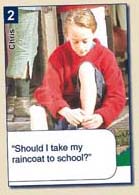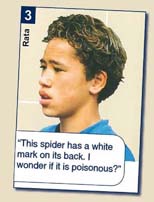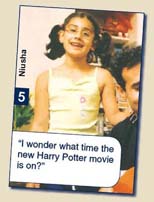|
||||||||||||||||
|
||||||||||||||||
| |
%
responses 2009 ('05) |
|||||||||||||||
y4 |
y8 |
|||||||||||||||
| Hand card 1 to the student. Mereana is at home. She wants to know whether the library has a book about turtles. 1. How could she find out? |
||||||||||||||||
 |
more than two ways that would work |
2 (0) |
11 (6) |
|||||||||||||
| more than two ways that would work, plus one or more that would not | 1 (1) |
2 (1) |
||||||||||||||
| two ways that would work | 12 (11) |
21 (23) |
||||||||||||||
| two ways that would work, plus one or more that would not | 6 (4) |
9 (6) |
||||||||||||||
| one way that would work | 22 (20) |
22 (16) |
||||||||||||||
| one way that would work, plus one or more that would not | 18 (18) |
17 (18) |
||||||||||||||
| Hand card 2 to the student. Chris is not sure whether or not he should take his raincoat to school. 2. How could he find out? |
||||||||||||||||
 |
more than two ways that would work |
9 (6) |
28 (30) |
|||||||||||||
| more than two ways that would work, plus one or more that would not | 1 (0) |
3 (5) |
||||||||||||||
| two ways that would work | 29 (26) |
34 (27) |
||||||||||||||
| two ways that would work, plus one or more that would not | 5 (7) |
5 (9) |
||||||||||||||
| one way that would work | 27 (35) |
19 (15) |
||||||||||||||
| one way that would work, plus one or more that would not | 12 (12) |
8 (10) |
||||||||||||||
| Hand card 3 to the student. Rata finds a spider with a white mark on its back. 3. How could he find out if it is poisonous? |
||||||||||||||||
 |
more than two ways that would work |
12 (4) |
29 (30) |
|||||||||||||
| more than two ways that would work, plus one or more that would not | 3 (0) |
4 (6) |
||||||||||||||
| two ways that would work | 26 (27) |
31 (30) |
||||||||||||||
| two ways that would work, plus one or more that would not | 6 (8) |
7 (3) |
||||||||||||||
| one way that would work | 26 (28) |
18 (12) |
||||||||||||||
| one way that would work, plus one or more that would not | 11 (11) |
7 (14) |
||||||||||||||
| Hand card 4 to
the student. Hazel’s family has moved to a new town. She wants to find out where the swimming pool is. 4. How could she find out? |
||||||||||||||||
 |
more than two ways that would work |
13 (9) |
29 (22) |
|||||||||||||
| more than two ways that would work, plus one or more that would not | 2 (0) |
3 (4) |
||||||||||||||
| two ways that would work | 26 (25) |
38 (40) |
||||||||||||||
| two ways that would work, plus one or more that would not | 6 (5) |
6 (6) |
||||||||||||||
| one way that would work | 21 (29) |
17 (16) |
||||||||||||||
| one way that would work, plus one or more that would not | 15 (20) |
4 (6) |
||||||||||||||
| Hand card 5 to the student. Niusha wants to go and see the new Harry Potter movie. She wants to find out what time it is on. 5. How could she find out? |
||||||||||||||||
 |
more than two ways that would work |
8 (7) |
25 (31) |
|||||||||||||
| more than two ways that would work, plus one or more that would not | 3 (0) |
2 (1) |
||||||||||||||
| two ways that would work | 25 (37) |
41 (37) |
||||||||||||||
| two ways that would work, plus one or more that would not | 6 (4) |
6 (4) |
||||||||||||||
| one way that would work | 32 (32) |
19 (17) |
||||||||||||||
| one way that would work, plus one or more that would not | 10 (11) |
4 (4) |
||||||||||||||
| Hand card 6 to the student. Hadyn wants to find out what the Mäori place name Waimaunga means. 6. How could he find out? |
||||||||||||||||
 |
more than two ways that would work | 13 (10) |
30 (22) |
|||||||||||||
| more than two ways that would work, plus one or more that would not | 2 (2) |
4 (4) |
||||||||||||||
| two ways that would work | 27 (31) |
35 (32) |
||||||||||||||
| two ways that would work, plus one or more that would not | 6 (3) |
4 (7) |
||||||||||||||
| one way that would work | 32 (28) |
18 (16) |
||||||||||||||
| one way that would work, plus one or more that would not | 10 (11) |
7 (12) |
||||||||||||||
Total
score: |
30–36 |
3 (1) |
14 (13) |
|||||||||||||
| 23–29 | 13 (8) |
35 (30) |
||||||||||||||
| 16–22 | 31 (30) |
33 (34) |
||||||||||||||
| 9–15 | 31 (37) |
15 (15) |
||||||||||||||
| 0–8 | 22 (24) |
3 (8) |
||||||||||||||
| Subgroup Analysis [Click on charts to enlarge] : |
| Commentary: |
| This task asked students to come up with ways to find answers to basic informational tasks that people encounter in their everyday lives. The total scores reflect the ability to come up with multiple ways of solving the problem. Looking at the responses for individual sub-tasks, it is clear that most children, at both years, could come up with at least one successful approach to finding the needed information. Performance improved slightly from 2005, and clear growth is seen from year 4 to year 8. Differences by gender and ethnicity were small. |

